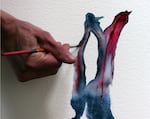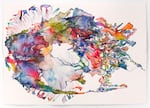Daniela Molnar remembers the artwork that changed her life.
“This Mark Rothko painting hit me like a cyclone,” Molnar says. At age 15, she sat pondering the Rothko painting for hours.
Later, she got a Master’s degree in scientific illustration and eventually worked for the prestigious Scientific American Magazine. That’s where Molnar got to work with foremost scientists who presented groundbreaking reports on climate change. She learned a lot, she says.
“I also learned I was not an illustrator.”
Molnar got burnt out on representational art. She says it felt rote. She knew deep down she needed to return to her first love: abstract expressionism.

Daniela Molnar blends her poetry with her artwork.
Daniela Molnar
Writer
Molnar sometimes blends her artwork with her poetry to create stunning videos and visual poems.
She starts her day early, journaling and writing.
“Other than my cat, no one else can be around. It’s a very meditative, almost trance state that I go into,” she says.
Her strong Judaic upbringing in New York City helped inspire her ear for poetry, says Molnar.
“I spent a lot of time listening to prayers and chants and songs,” she says. “I think that incantatory power of the prayers and the rituals infused my body and my sense of how language can work.”
Her flute playing also informed her writing, she says. Molnar practiced playing the flute for hours every day from age 6 to 19.
“Robert Pinsky is a poet who has written about how breath is like the primary medium of poetry and that really resonates with me,” she continues. “Because a lot of my flute training was learning to regulate my breath and learning how very small modulations of breath can create a completely different note or a different emotion. So I think that all influenced my sense of sound and music and language.”
Pigment forager and paint maker

Artist Daniela Molnar forages for pigment sources in her neighborhood.
Stephani Gordon / OPB
Molnar is part of a “thriving subculture of people who trade pigments,” she says.
She forages for paint sources in the wilderness and in Portland.
She sees it as “primarily an act of listening. It’s a way to go out into the world and to try to pay attention to the place and what it offers.”
To make pigment, she grinds and mulls rocks, concrete, terra cotta and other hard substances into finer particles.
Molnar then mixes the pigment with water that she collects when participating in residencies all over the world.
Water from oceans, rivers, lakes, hot springs and other sources “have different intelligences” and change the feel of the paint, she says.

Colors dance when Daniela Molnar drops homemade paint into water on paper.
Stephani Gordon / OPB
When she finds plants and roots, she boils them.
Sometimes she adds honey, gelatinous mushroom, gum arabic or other binders to her pigments.
She combines natural and synthetic pigments, delighting in “the exciting and unpredictable effects that arise,” but also “because it poses really relevant questions about what is nature at this point in time? If nature is the absence of human influence, then nature no longer exists,” she says.
The New Earth series
Molnar launched a climate change art series after attending a lecture about the Eliot Glacier at Mount Hood. She was shown NASA satellite pictures of the changing shape of the melting glacier.
“I just looked at that shape and I was like, ‘that’s an incredible shape.’ Just aesthetically, it captivated me. And I started the New Earth series,” she continues.
“I went back to my studio and just started experimenting with what happens if I use that shape as the basis for a painting.”
She uses satellite images to derive the shape of glacier recessions all over the world. She then projects the “shape of loss” onto a piece of paper and traces it. Afterwards, she paints the shapes, layered with other shapes of glacier loss.
“They’re incredible shapes in and of themselves, but they’re heartbreaking, they’re tragic, they’re the shape of a loss that we’re never going to recover,” she says.

Each shape in the New Earth Series is an image of glacier loss. Daniela Molnar finds the images of loss from satellite photos around the world.
Daniela Molnar
The New Earth paintings “give people a way to think about these issues that’s sort of an inviting welcome rather than like being barraged with more facts.”
Buying organic cabbage instead of the non-organic cabbage won’t solve climate change, says Molnar.
“Most people in the world are simply trying to feed themselves and their families. So when we get caught up in trying to buy the right olive oil, it’s such a privileged stance to take that, it eclipses the wider view,” she says.
“What we really need, rather than obsessing about consumer behavior, is to think about how to create massive systemic change.”